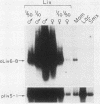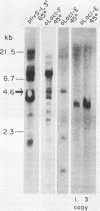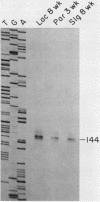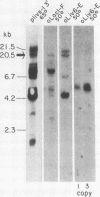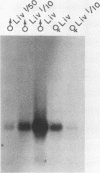Abstract
Mouse major urinary proteins (MUPs) are encoded by a family of about 35 to 40 highly conserved genes. In the preceding paper (K. Shahan, M. Gilmartin, and E. Derman, Mol. Cell. Biol. 7:1938-1946, 1987), we presented the sequences of the most abundant MUP mRNAs in the liver (MUP I, II, and III) and in the lachrymal (MUP IV) and submaxillary (MUP V) glands. We have shown that these five mRNAs are coded by five distinct genes, MUP I through V. In the present communication, we examine the expression of MUP genes in all of the six tissues in which MUP mRNAs are synthesized, the mammary, parotid, sublingual, lachrymal, and submaxillary glands and the liver. We show that gene MUP II is expressed in the liver and in the mammary gland, that gene MUP IV is expressed in the lachrymal and parotid glands, and that gene MUP V is expressed in the submaxillary, sublingual, and lachrymal and parotid glands, and that gene MUP V is expressed in the submaxillary, sublingual, and lachrymal glands. Furthermore, we present evidence that in addition to genes MUP I through V, another gene, MUP VI, is expressed in BALB/c mice in the parotid gland. The tissue-specific synthesis of MUP mRNAs is thus brought about by two major mechanisms: the expression, in different tissues, of different members of the family and the expression of a single gene at various levels in different tissues. When a particular MUP gene is expressed in several tissues, transcripts of this gene initiate at the same site and are spliced and polyadenylated in the same manner.
Full text
PDF







Images in this article
Selected References
These references are in PubMed. This may not be the complete list of references from this article.
- Bennett K. L., Lalley P. A., Barth R. K., Hastie N. D. Mapping the structural genes coding for the major urinary proteins in the mouse: combined use of recombinant inbred strains and somatic cell hybrids. Proc Natl Acad Sci U S A. 1982 Feb;79(4):1220–1224. doi: 10.1073/pnas.79.4.1220. [DOI] [PMC free article] [PubMed] [Google Scholar]
- Bishop J. O., Clark A. J., Clissold P. M., Hainey S., Francke U. Two main groups of mouse major urinary protein genes, both largely located on chromosome 4. EMBO J. 1982;1(5):615–620. doi: 10.1002/j.1460-2075.1982.tb01217.x. [DOI] [PMC free article] [PubMed] [Google Scholar]
- Clark A. J., Clissold P. M., Bishop J. O. Variation between mouse major urinary protein genes isolated from a single inbred line. Gene. 1982 Jun;18(3):221–230. doi: 10.1016/0378-1119(82)90159-7. [DOI] [PubMed] [Google Scholar]
- Clark A. J., Ghazal P., Bingham R. W., Barrett D., Bishop J. O. Sequence structures of a mouse major urinary protein gene and pseudogene compared. EMBO J. 1985 Dec 1;4(12):3159–3165. doi: 10.1002/j.1460-2075.1985.tb04059.x. [DOI] [PMC free article] [PubMed] [Google Scholar]
- Clark A. J., Hickman J., Bishop J. A 45-kb DNA domain with two divergently orientated genes is the unit of organisation of the murine major urinary protein genes. EMBO J. 1984 Sep;3(9):2055–2064. doi: 10.1002/j.1460-2075.1984.tb02091.x. [DOI] [PMC free article] [PubMed] [Google Scholar]
- Clayton D. F., Weiss M., Darnell J. E., Jr Liver-specific RNA metabolism in hepatoma cells: variations in transcription rates and mRNA levels. Mol Cell Biol. 1985 Oct;5(10):2633–2641. doi: 10.1128/mcb.5.10.2633. [DOI] [PMC free article] [PubMed] [Google Scholar]
- Derman E. Isolation of a cDNA clone for mouse urinary proteins: age- and sex-related expression of mouse urinary protein genes is transcriptionally controlled. Proc Natl Acad Sci U S A. 1981 Sep;78(9):5425–5429. doi: 10.1073/pnas.78.9.5425. [DOI] [PMC free article] [PubMed] [Google Scholar]
- Derman E., Krauter K., Walling L., Weinberger C., Ray M., Darnell J. E., Jr Transcriptional control in the production of liver-specific mRNAs. Cell. 1981 Mar;23(3):731–739. doi: 10.1016/0092-8674(81)90436-0. [DOI] [PubMed] [Google Scholar]
- Ghazal P., Clark A. J., Bishop J. O. Evolutionary amplification of a pseudogene. Proc Natl Acad Sci U S A. 1985 Jun;82(12):4182–4185. doi: 10.1073/pnas.82.12.4182. [DOI] [PMC free article] [PubMed] [Google Scholar]
- Hastie N. D., Held W. A., Toole J. J. Multiple genes coding for the androgen-regulated major urinary proteins of the mouse. Cell. 1979 Jun;17(2):449–457. doi: 10.1016/0092-8674(79)90171-5. [DOI] [PubMed] [Google Scholar]
- Klein R. M. Acinar cell proliferation in the parotid and submandibular salivary glands of the neonatal rat. Cell Tissue Kinet. 1982 Mar;15(2):187–195. doi: 10.1111/j.1365-2184.1982.tb01037.x. [DOI] [PubMed] [Google Scholar]
- Powell D. J., Friedman J. M., Oulette A. J., Krauter K. S., Darnell J. E., Jr Transcriptional and post-transcriptional control of specific messenger RNAs in adult and embryonic liver. J Mol Biol. 1984 Oct 15;179(1):21–35. doi: 10.1016/0022-2836(84)90304-8. [DOI] [PubMed] [Google Scholar]
- Redman R. S., Sreebny L. M. Morphologic and biochemical observations on the development of the rat parotid gland. Dev Biol. 1971 Jun;25(2):248–279. doi: 10.1016/0012-1606(71)90030-3. [DOI] [PubMed] [Google Scholar]
- Shahan K., Derman E. Tissue-specific expression of major urinary protein (MUP) genes in mice: characterization of MUP mRNAs by restriction mapping of cDNA and by in vitro translation. Mol Cell Biol. 1984 Nov;4(11):2259–2265. doi: 10.1128/mcb.4.11.2259. [DOI] [PMC free article] [PubMed] [Google Scholar]
- Shahan K., Gilmartin M., Derman E. Nucleotide sequences of liver, lachrymal, and submaxillary gland mouse major urinary protein mRNAs: mosaic structure and construction of panels of gene-specific synthetic oligonucleotide probes. Mol Cell Biol. 1987 May;7(5):1938–1946. doi: 10.1128/mcb.7.5.1938. [DOI] [PMC free article] [PubMed] [Google Scholar]
- Shaw P. H., Held W. A., Hastie N. D. The gene family for major urinary proteins: expression in several secretory tissues of the mouse. Cell. 1983 Mar;32(3):755–761. doi: 10.1016/0092-8674(83)90061-2. [DOI] [PubMed] [Google Scholar]



